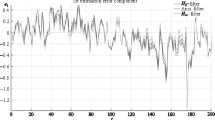Abstract
We consider the problem of anisotropy-based analysis of the robust quality linear discrete time-varying systems with finite horizon under random external disturbance. Uncertainty in the probability distributions of disturbance vectors is found with the information-theoretic notion of anisotropy and additional conditions on the first two moments. The quality of operation of the object is defined by the value of the anisotropic norm of the input-output matrix corresponding to the system. We show that computing the anisotropic norm of a time-varying system in the state space with non-centered disturbance is related to solving a system of difference matrix equations and equations of a special form. We show a sample computation of the anisotropic norm for a time-varying system with finite horizon.
Similar content being viewed by others
References
Doyle, J., Glover, K., Khargonekar, P., and Francis, B., State-Space Solutions to Standard H2- and H∞-Control Problems, IEEE Trans. AC, 1989, vol. 34, pp. 831–848.
Gu, D.-W., Tsai, M.C., O’Young, S.D., and Postletwaite, I., State-Space Formulae for Discrete-Time H∞ Optimization, Int. J. Control, 1989, vol. 49, pp. 1683–1723.
Bernstein, D.S. and Haddad, W.M., LQG Control with an H∞ Performance Bound: A Riccati Equation Approach, IEEE Trans. AC, 1989, vol. 34, pp. 293–305.
Haddad, W.M., Bernstein, D.S., and Mustafa, D, Mixed H2/H∞ Regulation and Estimation: The Discrete Time Case, Syst. Control Lett., 1991, vol. 16, pp. 235–247.
Khargonekar, P.P. and Rotea, M.A, Mixed H2/H∞ Control: A Convex Optimization Approach, IEEE Trans. AC, 1991, vol. 36, pp. 824–837.
Rotea, M.A. and Khargonekar, P.P., H2-Optimal Control with an H∞-Constraint: The State Feedback Case, Automatica, 1991, vol. 27, no. 2, pp. 307–316.
Zhou, K., Glover, K., Bodenheimer, B.A., and Doyle, J.C, Mixed H2 and H∞ Performance Objectives. I. Robust Performance Analysis, II. Optimal Control, IEEE Trans. AC, 1991, vol. 39, pp. 1564–1574; pp. 1575–1587.
Semyonov, A.V., Vladimirov, I.G., and Kurdjukov, A.P, Stochastic Approach to H∞-Optimization, Proc. 33 IEEE Conf. Dec. Control., 1994, vol. 3, pp. 2249–2250.
Vladimirov, I.G., Kurdyukov, A.P., and Semyonov, A.V, Anisotropy of Signals and the Entropy of Linear Stationary Systems, Dokl. Math., 1995, vol. 51, pp. 388–390.
Vladimirov, I.G., Kurdjukov, A.P., and Semyonov, A.V, On Computing the Anisotropic Norm of Linear Discrete-Time-Invariant Systems, Proc. 13th IFAC World Congress, San-Francisco, USA, 1996, pp. 179–184.
Vladimirov, I.G., Kurdjukov, A.P., and Semyonov, A.V., State-Space Solution to Anisotropy-Based Stochastic H∞-Optimization Problem, Proc. 13 IFAC World Congress, San Francisco, 1996, vol. H, pp. 427–432.
Vladimirov, I.G., Kurdjukov, A.P., and Semyonov, A.V, Asymptotics of the Anisotropic Norm of Linear Time-Invariant Systems, Autom. Remote Control., 1999, vol. 60, no. 3, part 1, pp. 359–366.
Vladimirov, I.G., Diamond, P., and Kloeden, P, Anisotropy-Based Robust Performance Analysis of Finite Horizon Linear Discrete Time Varying Systems, Autom. Remote Control., 2006, vol. 67, no. 8, pp. 1265–1282.
Maximov, E.A., Kurdyukov, A.P., and Vladimirov, I.G, Anisotropy-Based Bounded Real Lemma for Linear Discrete Time Varying Systems, Proc. 18 IFAC World Congress, Milano, Italy, 2011, pp. 4701–4706.
Kurdyukov, A., Kustov, A., Tchaikovsky, M., and Karny, M, The Concept of Mean Anisotropy of Signals with Nonzero Mean, Proc. Int. Conf. Process Control, Strbske Pleso, Slovakia, 2013, pp. 37–41.
Cover, T.M. and Thomas, J.A., Elements of Information Theory, New York: Wiley,2005, 2nd ed.
Diamond, P., Kloeden, P., and Vladimirov, I, Mean Anisotropy of Homogeneous Gaussian Random Fields and Anisotropic Norms of Linear Translation-Invariant Operators on Multidimensional Integer Lattices, J. Appl. Math. Stoch. Anal., 2003, vol. 16, pp. 209–231.
Lofberg, J., YALMIP: A Toolbox for Modeling and Optimization in MATLAB, Proc. CACSD Conf., Taipei, Taiwan, 2004. http://users.isy.liu.se/johanl/yalmip/
Sturm, J.F, Using SeDuMi 1.02, A MATLAB Toolbox for Optimization over Symmetric Cones, Optim. Methods Software, 1999, vol. 11, pp. 625–653.
Author information
Authors and Affiliations
Corresponding author
Additional information
Original Russian Text © A.Yu. Kustov, V.N. Timin, 2017, published in Avtomatika i Telemekhanika, 2017, No. 6, pp. 18–35.
This paper was recommended for publication by L.B. Rapoport, a member of the Editorial Board
Rights and permissions
About this article
Cite this article
Kustov, A.Y., Timin, V.N. Anisotropy-based analysis for finite horizon time-varying systems with non-centered disturbances. Autom Remote Control 78, 974–988 (2017). https://doi.org/10.1134/S0005117917060029
Received:
Published:
Issue Date:
DOI: https://doi.org/10.1134/S0005117917060029




